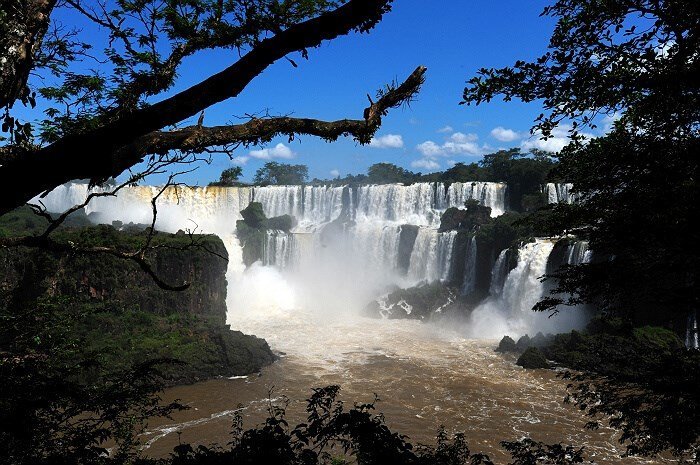South American Highlights - "Great Water" Iguazu Falls
Cataratas-del-Iguazu is the largest of the world's three most famous waterfalls. It is also the widest and most beautiful waterfall in the world. It is located on the border between Argentina and Brazil, the Iguazu River, and the second largest river in South America. It is a horseshoe-shaped waterfall 23 kilometers upstream of the Parana River confluence, 82 meters high, 4 kilometers wide, and the average drop is 75 meters. Iguazu means "big water" and was listed as a World Natural Heritage Site by UNESCO in 1984. In the dry season, the Iguassu Falls fault is divided into 270-300 large and small waterfalls. In the rainy season, it gathers into a magnificent world's widest waterfall. The water flow reaches a staggering 12,700 cubic meters per second, which is the largest in the world. waterfall.
Iguassu Falls is the last waterfall in the world's three largest waterfalls. Coincidentally, the three major waterfalls are the international border waterfalls. Niagara Falls in the United States and Canada and the Victoria Falls in Zimbabwe, Africa, I have visited. In this visit to Iguazú, we took two days on the two sides of Argentina and Brazil, using the three ways of sea, land and air, and multi-azimuth angles to capture, enjoy and intimately experience and experience the vastness of Iguazu. , affinity and mighty.
.jpg)
.jpg)
.jpg)
.jpg)

South American Highlights - Colorful Canyon in Northwest Argentina
By way of the northwestern highlands of Argentina, the small crossroads of land passing through Bolivia on a self-guided pass are one of the highlights of our trip. This not only saves travel distance, time, and money, but most importantly it is our discovery of the Northwest Plateau of Argentina for the first time, the discovery of Jujuy Province, the discovery of PURMAMARCA and HUMAHUACA Grand Canyon, and the discovery of this little-known natural heritage site in the world. I remember that at the company’s Cancun annual meeting in late April this year, when we met with our Argentinian colleagues and chatted with him about Jujuy and Humahuaca, he was very surprised that we Chinese could even visit the remote backwaters of Argentina, the colorful rocks of Serrainias del Hornocal in Humahuaca. Wall even had no place where he did not know Argentinians and had never wanted to. In addition, it is quite difficult for this route to enter Bolivia. This is a follow-up and requires strategies.
.jpg)

.jpg)
.jpg)
South American highlights - psychedelic polar sky
The mirror of the sky is the famous Salar de Uyuni, which is located near the town of Uyuni in southwestern Bolivia. It is the world’s largest plateau salt marsh and is approximately 250 kilometers from east to west and approximately 100 kilometers from north to south. With an area of over 10,500 square kilometers, it is rich in rock salt and gypsum. Due to its large area, flat and smooth surface and high reflectivity in the shallow water layer, it has become a state of the sky. The Uyuni salt marsh is located in the western plateau of Potosi Province, Bolivia, at an elevation of 3,660 meters. The rainfall is scarce all year round, and the climate is dry. It is only through the Lipez River that water is released during the wet period from December to the end of February. Only from December of each year to the beginning of April of the following year can we see the "sky environment" with a high probability.
.jpg)
.jpg)
.jpg)

Plateau of Pious Borders Eduardo-Avaroa National Nature Reserve
The Eduardo Abaroa The Andean Fauna National Reserve (REA) is located in the plateau protected area on the southwest corner of Bolivia and is one of the most visited areas in Bolivia. It has an altitude of 4,200 to 5,400 m and an area of 714,700 hectares. It is one of the world's worst annual rainfall regions and one of the driest regions in the world. The landscape is dominated by hot springs, geysers, geothermal, salt lakes, volcanic sites, up to 40 species of flamingos and 3 species of flamingos and geese unique to Bolivia. Its most famous landscape is the Red Lake Wildlife Conservation Area (Laguna). Colorada National Wildlife Sanctuary, Laguna Verde, Laguna Honda, etc.
.jpg)
.jpg)
.jpg)

Beautiful ! excellent article !!!
@romanaround
@banjo